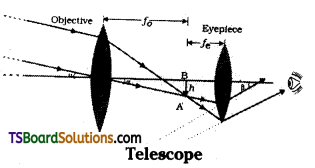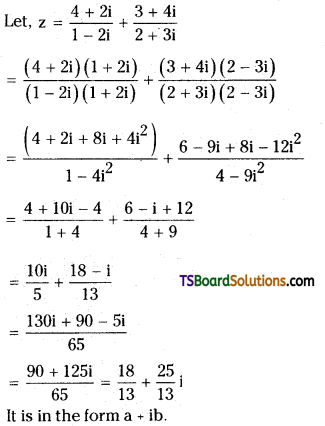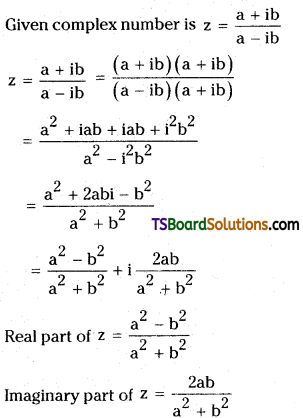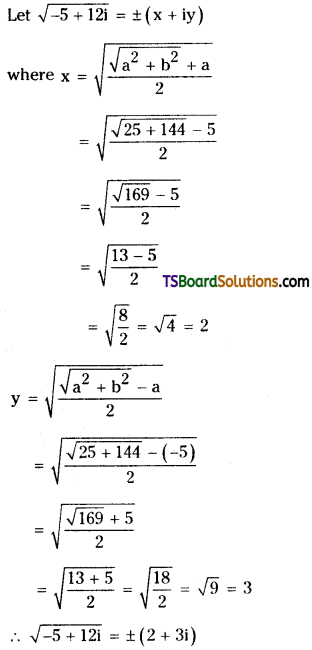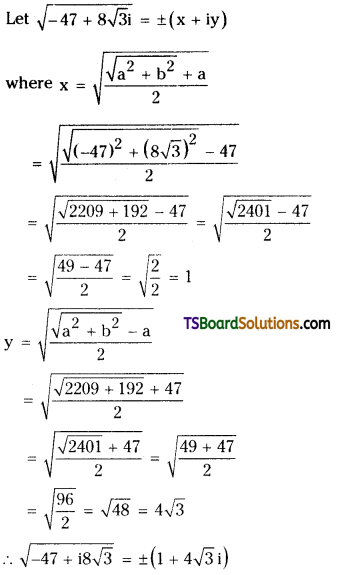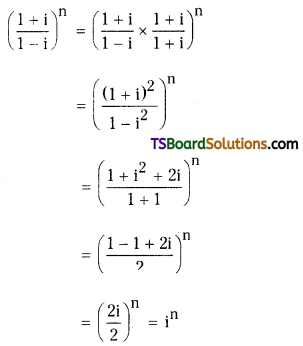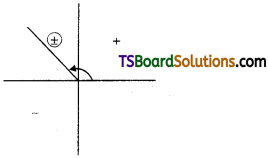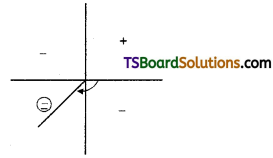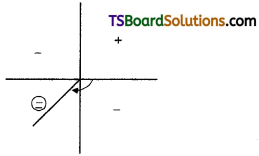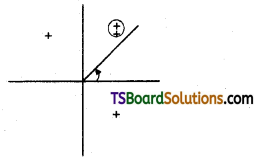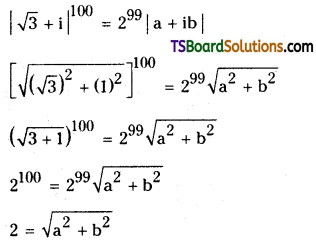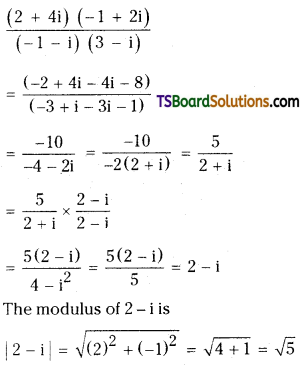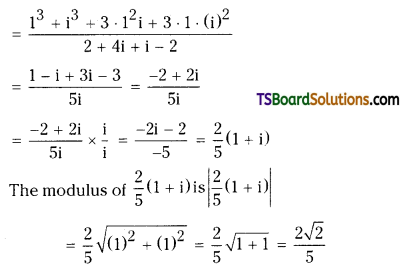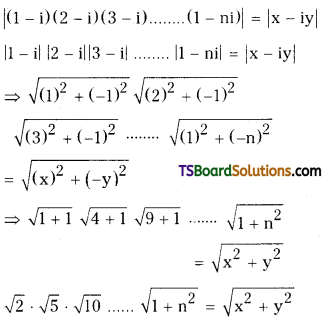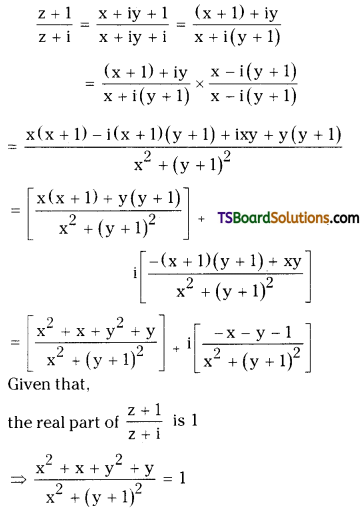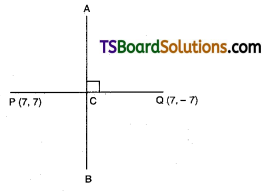Telangana TSBIE TS Inter 2nd Year Political Science Study Material 1st Lesson Indian Constitution-Historical Background Textbook Questions and Answers.
TS Inter 2nd Year Political Science Study Material 1st Lesson Indian Constitution-Historical Background
Long Answer Questions
Question 1.
Explain the causes for the Origin of Indian National Movement.
Answer:
Indian National Movement was organized during 1857 -1947 in both Violent and Non – Violent forms. The First war of Independence in 1857 known as a Great Revolt by Indian Soldiers sowed the seeds of Nationalism among Indians. With the formation of Indian National Congress in 1885, the movement for National Independence took a Non – Violent form. The National Movement united people of different groups to fight against the British Repression.
The Following are the causes for the birth of Indian National Movement:
1) British Colonial Rule :
British colonial rule is said to be one of the important cause for the birth and growth of nationalism in India. The British rulers developed communication facilities such as road, rail, press, posts and telegraphs for preserving their administrative, political and economic interests in India. The leaders of Indian National Movement properly availed such facilities and informed the Indian masses about tyrannic and exploitative policy of the British colonial rulers. The political unity rendered by the British rulers also brought the feelings of unity among the Indians.
2) Socio – Cultural Renaissance :
Several Social and Cultural Movements were witnessed in India during the 19th century which brought social awakening and the ideas of Cultural Nationalism. The Brahma Samaj founded by Raja Rammohan Roy, pioneered these movements and gave a call for reform against social evils such as Sati, Child marriages, Widowhood, Idol Worship, Seclusion and others. This was followed by Arya Samaj, The Ramakrishna mission, The Theosophical Society, Prartana Samaj, the Aligarh movement, Satyasodhak Samaj, and Wahabi Movement. These movements have infused the ideas of rationalism, socio-cultural identity and patriotism and indirectly motivated the people to have an urge for self-rule.
3) Great Revolt:
1857 Revolt was the first great challenge to the British rule in India. The Revolt inspired the struggle for Indian Independence. It gave courage to Indians against the British.
4) English Education :
English was introduced in India as a medium of instruction and correspondence by the British rulers on the recommendations of ford Macaulay committee. A few educated elite among Indians travelled in England to gain proficiency in English language. They were able to study and understand the views of eminent thinkers like Hobbes, Locke, Rousseaue, J.S.Mill and Karl Marx on several concepts like liberty, equality/fraternity, independene, democracy etc. They communicated the value and importance of these ideas to Indians in various regional languages This inspired the Indian masses to participate in the freedom struggle.
5) Economic Exploitation :
The British government transformed India into a safe citadel for British investments, markets and export of Indian raw materials. It suppressed the growth of Indian cottage, village and small scale industries for safe guarding the British investments on permanent basis. The British Governor generals like Lord Lytton and Curzon, implemented such policies suited to the British investors exploiting the national wealth of India. This has caused bitter resentment among the Indian industrialists, cottage and small scale artisans. Hence, they were attracted towards the freedom movement in India.
6) Famines and Acute poverty:
During 19th century several famines took place, but the British government had not done anything for the people. Poverty is another cause. Number of people died because of starvation. This led to great dissatisfaction among the Indians and enabled them to fight against the British government.
7) Press :
Many Journals and dailies were published and circulated in India during freedom movement. Ex : Amrit Bazar, Kesari, Marata, Hindu, Andhra Patrika etc. They created, enhanced national feelings among themselves. They played a crucial role in spreading National feelings and conveyed the desires and demands of people to the Britishers.
8) Repressive Rule :
The Arms Act and Vernacular Press Act passed by Lord Lytton and his Kabul invasion hurt the sentiments of Indians. The llbert Bill Proposed by Lord Rippon and its withdrawl made the Indians understand the racial hatred of the British.
9) Racial Discrimination :
Indians were treated as second rate citizens and were excluded from higher posts. The British ploicy of racial discrimination aroused and strengthened Nationalism in India.
10) Emergence of the Indian National Congress :
1885 was a landmark in the history of Indian National Movement. A.O. Hume, the British Civil Servant established the Indian National Congress on 28th December, 1885 at Mumbai in Gokul Tejpaul Sanskrit College and developed the nationalist feelings among the people. W.C. Banerjee was the first President of the Congress.

Question 2.
Describe the various phases of Indian National Movement.
Answer:
Stages of the Indian National Movement : Dr. Ramesh Chandra an eminent historian, has divided the history of Indian National Movement into three stages, namely :
- Moderate stage (1885 – 1905)
- Extremist stage (1905 – 1920)
- Gandhian stage (1920 – 1947)
Let us examine these three stages in detail.
1) Moderate stage :
The early leaders of the Congress are known as the “Moderates”. They dominated the first stage of the freedom movement from 1885 to 1905. They had full faith in the British sense of justice and fair play. They emphasised the use of peaceful and constitutional methods to achieve their aims and objectives. They did not believe in agitation or unconstitutional methods. They carried on their work by means of public debates, propaganda, petitions, demonstrations and deputations.Their motto was “reform, not revolution”.The prominent leaders of this group are W.C.Benerjee, Pherozshah Mehta, Dadabhai Baoroji, Surendranath Benerjee, Bodaruddin Toyabji, Dinshaw Wacha R.E. Dutt., L.M. Chose, Ranade, G.K. Gtokhale etc.
Demands of Moderates : The demands of the Moderates are :
- Reduction in the military expenditure.
- Abolition of the Indian Council.
- Holding Civil Service Examinations in India simultaneously with that of England.
- Expansion of the Legislative councils so as to include more and more Indians.
- Separation of judiciary from executive.
- Reduction in land revenue and granting occupancy rights to the tillers.
- Irrigation facilities to the farmers.
- Stoppage of export of food grains.
- Higher jobs to the Indians.
- Reduction in taxes.
2. Extremist stage (1906 -1919):
The second stage of the National Movement was dominated by the extremists from 1906 to 1918. During this period the congress entered the militant stage. The prominent leaders of this group are Bala Gangadhar Tilak, Lala Lajpat Roy and Bipin Chandrapal. They advocated the use of militant methods.They raised the slogans of “Swaraj” and “Swadesi” and Laid stress on National Education.
Demands of Extremists :
Extremists regarded the British rule as a curse for India. They had faith in the superiority of Vedic culture, literature language and civilisation. They demanded the introduction of self government in the country. They did not demand petty concessions but favoured complete Swaraj. They gave the people the slogan that “Freedom was their birth right and they must have it”.
The moderates preferred action to peaceful methods for achieving the goals. They had no faith in petitions and representations. They laid emphasis on boycott of foreign goods and use of Swadesi goods.
3. Gandhian stage (1920 -1947):
The third stage of the National Movement was dominated by Mahatma Gandhi from 1920 to 1947. That is why this period is known as the “Gandhian period”. He launched his first non-violent and non-cooperation movement in 1920.
The movement included the boycott of foreign goods, legislative councils, law Courts, schools and colleges. But, when the movement look a violent course, he suspended it abruptly in 1922. In 1924, he vvas elected as congress president and called upon to organise demonstrations against Simon Commission in 1927. In 1929, the Congress at its Lahore session declared its goal as achievement of’complete independence”.
In March, 1930 Gandhiji started his second agitation known as “Civil disobedience Movement” or “Salt Satyagraha”. Gandhiji asked the British to “Quit India” and gave a call of “Do or Die”.
After the Second World -War, the labour party, headed by Clement Atlee came to power in England. He sent cabinet mission to India. On the basis of cabinet mission plan and Mountbatten plan, the British) parliament passed the Indian Independence Act. India became independent on 15th August, 1947.
Question 3.
Critically analyse the provisions in the Government of India Act 1935.
Answer:
The Government of India Act, 1935 was considered to be the second mile stone in the introduction of the responsible government in India. Different factors like Indian Nationalism, British imperialism, communal tendencies etc, influenced in a way or the other in adopting this Act. Similarly various factors, like reports of Muddiman committee (1924), Simon Commission (1927), the deliberations of three Round Table Conferences (1930,1931 & 1932), Communal Award (1932), White Paper (1933), Report of Joint Parliamentary Committee (1934) etc., formed bases for adopting this Act. This Act was a detailed and lengthy one, containing 14 parts and 10 schedules.
Main Provisions:
- The Act prescribed Quasi – rigid and Quasi – flexible methods to amend the provisions.
- While it abolished dyarchy in the provinces, it introduced the same at the union level.
- It provided provincial autonomy in the states and paved the way for a complete responsible rule.
- It split the administrative subjects of the Union Government into two lists – Reserved and Transferred. While the reserved list comprised Defence, External affairs, Tribal welfare, Communal issues, the remaining subjects were brought under transferred category.
- The Act has enlarged the sphere of electorate and various legislatures.
- It provided for bicameralism at the centre and in six out of eleven provinces.
- It constituted a federal court in order to settle the conflicts between the union and the provinces or between the provinces.
- It proposed an All India Federation, having two governments (union and states), division of powers, written and rigid constitution, federal court etc. It included 59 items in federal or central list and 54 items in provincial list. It has incorporated certain other subjects like civil and criminal procedure code, Marriage, Divorce, Endowments, Contracts, Press etc, in the concurrent list.
- It gave freedom to the native provinces either to join or Quit the Federation.
- The Act has brought about far reaching changes in the home administration in India. It abolished the Indian Council and authorized the secretary of state to appoint 3 to 6 members to assist in his duties.
- New provinces Orissa and Sindh were created.
- Separate Representation for Indian Christians, Anglo Indians, Europeans and Depressed classes in Legislative Councils.
Criticism :
This Act Could not satisfy the Nationalist aspirations of the people for both political and economic power continued to be concentrated in the hands of the British. This Act was criticised for providing despotic powers to governor general. Indian National Congress Condemned this Act and demanded for Complete Independence and formation of a constituent Assembly to draft a New Constitution.

Question 4.
Explain the salient features of Indian Constitution.
Answer:
Introduction:
The Indian Constitution was prepared and Adopted by the Constituent Assembly, which was set up in 1946. The Constituent Assembly took nearly three years From 9th December,1946 to 25th November, 1949 (2 years, 11 months and 18 days) to complete the framing of the Costitution. The Constituent Assembly approved the Indian Constitution on 26th November, 1949. The Indian Costitution came into force on 26 January, 1950, which we have been celebrating as “The Republic Day”. The following are the salient or basic features of the Indian Constitution.
1) Written and Detailed Constitution :
The Constitution of India is a written document. It consists of 12 Schedules, 22 Parts and 444 Articles. Many factors have contributed for the bulkiness of the Constitution. All most all matters relating to the composition and organization of union, states as well as Union Territories, provisions regarding protection of interests of Schedules castes, Scheduled Tribes and other Backward classes, provisions regarding Special Constitutional bodies like the Election Commissions, the UPSC and State Public Service Commissions are made in a very comprehensive. manner. Similarly, several matters relating to Fundamental Rights, Fundamental Duties, Directive principles of state policy, Union – State Relations, Official Language and Regional Languages were clearly mentioned in the Costitution.
2) India is a Sovereign, Socialist, Secular, Democratic, Republic:
The constitution deliberately designed India to be a Sovereign, Socialist, Secular, Democratic, Republic. Each of these concepts has wide ranging dimensions.
Sovereign State :
India is a Sovereign State. It is clear that India is internally Supreme and externally independent of any foreign control. India is not a sub-ordinate State.
Socialist State :
According to the preamble India is committed to Socialism assuring the establishment of a socialist State. It strives to provide social and economic Justice to all its people and end all forms of exploitation. We follow mixed economy. The State is free to bring the key industries and the private enterprises under the state ownership and management.
Secular State :
Secularism means that the State protects all religions equally and does not itself subscribe to any other religion as official.
Democratic State :
Democracy is the formidable foundation of Indian political system. It states that the people of India are the chief source of the Political Authority they can make and unmake the government. The people are both the Rulers and the ruled. India adopted Indirect or Representative Democracy.
Republican State :
India is a Republic with an elected Head of the State i.e., the President of India. No public office in the country is hereditary. Any Indian citizen can contest to any office of the government subject to certain limitations.
3) Noble Aims and objectives :
Indian constitution has noble aims and objectives. The Indian constitution secures to all its citizens, Justice – Social, Economic, and Political matters. It also provides all its citizens, liberty of thoight, expression, belief, faith, and worship. Further, the constitution of India promotes among all people the equality of status and opportunity. Like wise it strives for fraternity by assuring the dignity of the individual and the unity and integrity of the Nation.
4) Combination of ligidity and Flexibility :
The Constitution of India can be amended with Rigid and Flexible method. Article 368 provides the details of the amendment procedure. It can be amended by three methods.
Firstly:
The Unio l Parliament can amend some parts of the constitution by a simple majority. Ex: The formation of new ates (Ex: Telangana), changing the boundaries of states, provisions relating to citizenship etc. It is said o be Flexible.
Secondly :
Some provisions can be amended by a special majority i.e., not less than Two Thirds (2/3) of the member of the House present and voting.
Ex : Fundamental Rights, Directive principles of state policy, etc. It is said to be half rigid and half flexible.
Thirdly:
Some provisions can be amended by Two – Thirds (2/3) majority of the parliament and with the concurrence c half of the states.
Ex: Election of the president, Executive powers of the union and the states, Distribution of Legislative powers between the union nd the states ete. lt is said to be Rigid.
Hence, the Constitu1 on has a combination of Rigid and Flexible methods to amend the Constitution.
5) Unitary and Federal Features :
India is a union of states according to the constitution. Our constitution contains both th features of unitary and Federal Governments. It prescribed unitary system in emergencies and federal lystem on ordinary occussions. Provisions of unitary state such as Single Citizenship, Single IntegratedBudiciary, Single election Commission, Roll of All India Services personnel etc., are found in our constitut on. At the same time certain federal features like written, Rigid constitution, Dual Government, Bicamenlism etc., are profoundly seen in our constitution. Thus it is a quasi – federal policy like Canada.
6) Parliamentary government:
The makers of our constitution adopted the Irish precedent of of a hereditary Monarch. They retained all other essential features of two types of executive heads, Prime Ministers leadership, collective’ responsibility, nominal position of the President, Parliaments control over the Union Executive etc. They prescribed the same type of political system for the states.
7) Independent Judiciary :
The constitution of India granted independent and integrated judiciary for Indians. Hence t ie Supreme Court and High Courts in India act independently without subject to the control of the executive and legislative organs, judiciary enjoys independence in the matters of appointment of judges, their tenure, salaries and allowances, service conditions, promotion etc. Our constitution clearly states that the executive and legislative authorities should refrain from interfering in the functioning of the judiciary. It conferred the power of judicial review on the judges of the Supreme Court and High Courts. It is due to the independent position that the Supreme Court and High Court judges will decide the propriety and constitutional validity of the acts and policies of the legislative and executive authorities in the country.
8) Directive Principles of State Policy:
Our constitution hinted our certain directive principles as the policy of the state in Part IV from Articles 36 to 51. The makers of our constitution derived these principles from Irish constitution. They pointed out that these principles would transform India into a welfare, gandhian and liberal oriented state. These principles must be implemented by all the parties which hold authority without political considerations.
These principles enable the state to provide a new social order based on economic, political and social justice. These principles include certain programmes like provision of employment opportunities, fair distribution of wealth, equal pay for equal work, educational and child care for thbse children below fourteen years, etc. Similarly unemployment relief, old age pension, protection against ill health, provsion of leisure for workers, conservation of wild life etc are included in these principle.
9) Fundamental Rights :
Our constitution mentioned fundamental rights on American model for the complete realization of the personality of Indian citizens. They are incorporated under Part III from Articles 12 to 35 of our constitution. Indian citizens can utilize these rights subject to certain rational restraints. Nobody including the government is allowed to interfere in these rights. The higher judicial organizations in the country help the citizens in safeguarding these rights. At first there were seven fundamental rights in the constitution. But at present there are only six fundamental rights. They are 1. Right to Equality 2. Right to Freedom 3. Right against Exploitation 4 Right to Religion 5. Cultural and Educational Rights and 6. Right to Constitutional Remedies.
10) Fundamental Duties :
Our constitution incorporated fundamental duties in Article 51 A under Part 4A. At first there were 10 fundamental duties inserted through the Constitution (Forty second) Amendment Act, 1976. Later one more duty was added through the Constitution (Eighty sixth) Amendment Act, 2002. Altogether there are Eleven Fundament Duties in our consititution. Respecting the consititution, National Flag, National Anthem, Safeguarding public property etc are come of the Fundamental duties.
11. Single Citizenship :
Our Constitution provides for single citizenship for all persons who are born in India and who resided in India for a specific period. It enables the citizens to possess and enjoy identical right and privileges. It also promotes unity, integrity and fraterrity among the people.
12. Universal Adult Franchise:
The makers of the Indian Constitution provided for the Universal Adult Franchise for all citizens without any discrimination based on caste, colour, creed, community, language, religion, region, sex, property etc. At the beginning, Adult Franchise was given to all the citizens who attained the age of 21 years. Later voting age was reduced to 18 years through the 61st Constitution Amendment Act in 1988.
13. Bicameralism :
The Constitution of India introduced Bi-cameralism at the National level. Accordingly, the Indian Parliament consists of two houses namely the Rajya Sabha (upper house) and the Lok Sabha (Lower house). While the Rajya Sabha represents the states, the Lok Sabha represents the people.
14. Panchayati Raj and Nagar Palika Acts :
The Panchayati Raj and Nagar Palikas Acts are recent features of our constitution. The 73rd and 74th constitutional recognition to the rural and urban local governments which came into force in 1993 and 1994 respectively had become operative all over the territory of India. The ideas of democratic decentralisation or the grassroof democracy are realised by these acts. These Acts provides for adequate representation for Womem, Scheduled Castes, Scheduled tribes and other Weaker Sections in the policy making bodies of the Local governments.
15. Special Provisions Relating to Scheduled Castes and Scheduled Tribes :
Indian Constitution hinted out certain specific directives for the development of scheduled castes and scheduled tribes in India. It enabled the union and state governments to review the steps taken for the improvement of backward classes through setting up o^ independent commissions. In this regard the union government was authorised to act as a coordinator between various state governments.
Short Answer Questions
Question 1.
Explain any four causes for the Indian National Movement.
Answer:
The British rule contributed to the emergence of Modern Indian Nationalism. The National movement united people of different groups to fight the Britishers. The following are the some causes for the birth of Indian National Movement.
1. British Colonial Rule :
British colonial rule is said to be one of the important cause for the birth and growth of Nationalism in India. The British rulers developed communication facilities such as road, rail, press, posts and telegraphs for preserving their administrative, political and economic interests in India. The leaders of Indian National Movement properly availed such facilities and informed the Indian masses about the tyrannic and exploitative policy of the British colonial rulers. The political unity rendered by tbe British rulers also brought the feelings of unity among the Indians.
2. English Education :
English was introduced in India as a medium of instruction and correspondence by the British rulers on the recommendations of ford Macaulay committee. A few educated elite among Indians travelled in England to gain proficiency in English language. They were able to study and understand the views of eminent thinkers like Hobbes, Locke, Rousseaue, J.S. Mill and Karl Marx on several concepts like liberty, equality, fraternity, independence, democracy etc.
3. Economic Exploitation :
The British government transformed India into a safe citadel for British investments, markets and export of Indian raw materials. It suppressed the growth of Indian cottage, village and small scale industries for safe guarding the British investments on permanent basis. The British Governor generals like Lord Lytton and Curzon, implemented such policies suited to the British investors exploiting the national wealth of India.This has caused bitter resentment among the Indian industrialists, cottage and small scale artisans. Hence, they were attracted towards the freedom movement in India.
4. Press :
Many Journals and dailies were published and circulated in India during freedom movement. Ex : Amrit Bazar, Kesari, Marata, Hindu, Andhra Patrika etc. They created, enhanced national feelings among themselves. They played a crucial role in spreading, National feelings and conveyed the desires and demands of people to the Britishers.

Question 2.
Explain the role of the extremists in Indian National Movement.
Answer:
The second stage of the National Movement (from 1906 to 1919) was dominated by the extremists. During this period, the Congress entered the militant stage. The prominent leaders were Lala Lajpat Roy, Bala Gangadhar Tilak and Bipin Chandra pal (Lai – Bal – Pal). The extremists criticised the moderates for pursuing the policy of “Mendicancy with a begging bowl” and advocated-the use of radical methods to realise Swaraj.
The extremists proposed new methods to achieve their objective! of self government. They declared openly that they had no faith in the goodness of the British. The extremists advocated (1) Boycott of foreign goods (2) Swadesi (3) Boycott of the Government controlled schools and colleges (4) Promoting National education and (5) Passive resistance.
The extremists appealed to the people not to assist the Government to rule. They wanted to create trouble to the Government to rule. They wanted to create trouble to the Government in collecting revenue. They were also against fighting beyond the frontiers or outside India with Indian blood and money. They even advocated that people must organise parallel courts to die British courts. Boycott of foreign goods and the use of Swadesi goods were popularised by the extremists.
They also adovacated boycott of British courts, municipalities and legislative councils. The extremists popularised education on national lines. In national education, the focus was on things Indian. The regional Indian language was to be the chief medium of instruction. The message of Swadesi began to reah the masses due to the methods used by the Extremists.
The extremists introduced new methods of political organisation and new ways of continuing political struggles. But the methods of passive resistance and non-co-operation remained mere ideas. It must also be said that over emphasis on Hindus religious symbols during the extremist National Movement created a rift between the Hindus and the Muslims. The mass of the common people were also outside the mainstream of national politics during the extremist movement despite their radical methods.
Question 3.
Write about the important events during the Gandhian phase of Indian National Movement.
Answer:
Gandhian phase (1920-1947) is the last and final stage of Indian National Movement. Gandhiji led many movements againts the British such as the Non Co-operation movement, Civil disobedience movement and ‘Quit India movement. They may be explained in the following ways.
1. Non Co-operation Movement (1920 to 1922) :
Gandhiji launched this Non-cooperation movement on August 1920 as a protest against the incidents of kilafat and Jallian Wallabagh. The Indian National Congress presided over by Nagapur session in 1921 headed by Lala Lajapathi Roy. There relate to a) Positive programmes like collecting Tilak fund Rs. one Crore and distributed 20 lakhs of charakas. b) Nagative programmes like renouncing British titles, honarary offices, Boycotting courts, schools, legislative councils, as a part Gandhi renounced his title Kaiker-E-Hind. But unfortunately this non-co-operation movement called off by Gandhi in 1922 due to the bad incident happened at Chouri-Choura. ‘
2. Civil Disobedience Movement (1930 to 1934):
The Indian National Congress lanunched this movement on 13th March, 1930 under the guidence of Gandhi. During the 1st stage Gandhiji asked the Indian masses to launch Salt Satyagraha. Gandhiji with his 78 staunch disciples launched a march from Sabarmathi to Dandi nearly 240 miles on 13th March 1930. In the second stage people voluntarily organised hartals, packetings, boycott, swadesi and other programmes. In the third stage between Aug. 1933 to May 1934 in this stage leaders launched collective and individual civil disobedience. Finally Gandhiji concentrated on non-political activites.
3. Quit India movement (1942 to 1944):
The Congress Working Committee at its meeting in worda on July 14, 1942 demanded the British Government on Quit India. Again the Congress in its meeting in Bombay 8th August 1942 approved the Quit India movement. In its 1st stage Britishers arrest Gandhi then National wide processions, demonistrations taken agitators destroyed police stations, railway stations and post offices. Peaceful conditions prevailed during the last stage. Quit India movement continued from 8th August, 1942 with the imprisonment of Gandhi to May 1944 with his release. Through this movement the British government too undestood. The patriotic feelings of the people. They conceded to grant Independence to Indians.

Question 4.
Describe the Home Rule Movement in India’s Freedom Struggle.
Answer:
Home Rule Movement is an important movement organized during the Indian freedom struggle. Lokmanya Bala Gangadhar Tilak and Annie Besant led this movement. The British government freed Tilak from Mondalay prison after six years of imprisonment. Tilak who returned to India decided to renew harmonious relations with Indian National Congress leaders and to behave positively with the British rulers through some constructive activities. He strived to form home rule councils on the pattern of Irish Councils.
He maintained contacts with the Irish Woman, Annie Besant of Madras (now Chennai), the founder of Divine Life Society. In 1916 both of them separately set up Home Rule Leagues and tried to create political awareness and spiritual enlightment among the people. Annie Besant founded New India and Common Wheel and appointed George Arundale as the organizational secretary of Home Rule League.
Tilak propagated the ideals of Home Rule League in Bombay (excepting Maharashtra), Karnataka, Central Province and Bihar. On the other hand Annie Besant spread the above ideals in the remaining parts of India. The two leaders propagated secular ideas preaching anti-caste and antireligious elements among the people. They extensively distributed home rule league pamphlets, throughout the country. The British government imprisoned Tilak in July, 1916 on the pretext that his conduct was not good. This enraged the followers of Tilak. Mohammad Ali Jinnah acted as the pleader for Tilak in district and High Courts and tried to bring him out of prison. Tilak intensified his agitation. While he founded home rule legue offices in six places, Annie Besant set up such offices in more than 200 places.
Question 5.
What are the various programmes adopted during the Non-cooperation Movement?
Answer:
Gandhiji started Non-cooperation Movement on 1st August, 1920. The Nagpur session of the Congress in 1920 ratified it. The programme of the Movement was as follows.
- Boycott of foreign goods and use of Swadeshi goods.
- Surrender of titles and honorary offices and resignation from nominated seats in local bodies.
- Boycott of Government and State-aided schools and colleges and establishment of National schools and colleges.
- Boycott of elections to the new Councils and refusal by the voters to vote at the elections.
- Refusal to attend official Durbars.
- Gradual boycott of British courts by lawyers and citizens.
- Refusal by soldiers, clerks and working people to serve in Mesopotamia.
The Non-cooperation Movement, in short, aimed at the boycott of colleges, courts, councils and Government jobs. Besides the boycott measures, the Congress also adopted a constructive programme. It included the opening of national educational institutions, the setting up of panchayats as a substitute of British courts, the popularisation of chakra palying etc.

Question 6.
What are the important provisions of Government of India Act,1919?
Answer:
The Govt, of India Act, 1919 or the Montague Chelmsford reforms made a beginning in the representative Govt, of India. Discontent over 1909 reforms, frustration among Indians, changes in the Muslim league policy, the first world war, the reunion of moderates and extremists in the congress, the Home rule movement, Montague’s declaration, Montford scheme etc., were some of the causes led to the adoption of this Act.
Main Provisions:
1. The Act removed the restrictions over the size of membership of Governor General’s Executive Council.
2. The Act made the executive responsible to the Central Legislative Assembly.
3. It fixed the membership of the council of states at 60 and that of the Central Legislative Assembly at 145 respectively.
4. It has provided considerable powers to the Central Legislative Assembly by empowering the latter to make laws on union list subject to the approval the Governor-General.
5. It has provided Dyarchy at the state level and divided provincial subjects into reserved subjects and transferred subjects. 28 subjects were included in the reserved category. Finance, Land Revenue, Justice, Police, Irrigation, Factories, Industries etc., were a few among them. The Governors of the provinces were to administer these subjects with the help of the British councillors.
The Act has listed 22 subjects in the transferred category. Local self Govt Agriculture, Public works, Public health, Co-operation, Education etc., were some such subjects. The Governors were to administer these subjects with the help of the Indian Ministers.
6. The Act has created die office of the secretary of State which acts as the agent of the British Govt in India.
7. The Act further divided the administrative subjects between the union and state governments into two types namely: (i) Union list and (ii). Provincial list It included 47 items in the union list Defence, Foreign affairs, Public debt, Posts and Telegraphs, Navigation, Export and Import Duties etc., were a few of such subjects. It has incorporated 51 items in the provincial list. Local government, Public health, Education, Agriculture, Forests, Law and order etc., formed part of this list.
8. The Act separated provincial budgets from that of the union. It empowered the provincial legislatures to approve their own budgets from that of the union. It empowered the provincial legislatures to approve their own budgets and levy taxes.
9. The Act introduced some changes in the composition of Indian Council. The size of Indian council was fixed between 8 and 12 its tenure at five years.
10. The Chamber of princes with viceroy as the chairman was constituted. The Govt of India Act, 1919 was considered to be a landmark in the constitutional history of India.
Question 7.
Point out the main provisions of the Independence of India Act, 1947.
Answer:
The main provisions of the Independence of the India Act 1947 may be explained as follows.
- India and Pakistan shall be constituted as two separate independent states.
- Two constituent Assemblies shall be formed each for India and Pakistan and work as constitution making bodies as well as legislative bodies in their respective domains.
- The British Supermacy over British India native princely states shall cease to exit. The princely states would be free to join either dominious or to remain independent.
- Territories of the two dominous were defined but they were empowered to include or exlude a territory themselves.
Question 8.
Write about any three basic features of Indian Constitution.
Answer:
1. Single citizenship :
Our Constitution provides for single citizenship for all persons who are bom in India and who resided in India for a Specific period. It enables the citizens to possess an enjoy identical rights and privilages. It also promotes unity, integrity and fraternity among the people.
2. Universal adult Franchise :
The makers of the Indian constitution provided for the universal adult franchise for all citizens without any discrimination based on caste, colour, creed, community, language, religion, region, sex, property etc., At the beginning, adult franchise was given to all the citizens who attained the age of 21 years. Later voting age was reduced to 18 years through the Constitution Amendment Act in 1988.
3. Bicameralism :
The constitution of India introduced Bi – cameralism at the national level. Accordingly, the Indian Parliament consists of two houses namely the Rajya Sabha (upper house) and Lok Sabha (lower house). While the Rajya Sabha represents the states, the Lok Sabha represents the people.
Very Short Answer Quenstions
Question 1.
Moderates in Indian National Movement.
Answer:
Dadabhai Naoroji, Copala Krishna Gokhale, Surendra Nath Benarjee, Umesh Chandra Benarjee are the prominent moderate leaders. They adopted peaceful and constitutional methods in articulating their demands in the National Movement. There include prayers, petitions protest and mediatious.

Question 2.
Methods of Extremists.
Answer:
- Boycott of British goods, honorary titles and Govt., offices.
- Encouraging native education.
- Striving for membership to Indian in Legislative Councils.
- Patronizing native goods and industries.
- Practicing passive resistance.
Question 3.
Simon Commission.
Answer:
The Commission had seven English men as members and Sir John Simon as Chairman. Hence, the Congress decided to boycott the Commission’s prceedings throughout the country and raised the slogan “Simon Go back”. Indians wholeheartedly obliged the call and protested against thes Simon Commission. Black flag demonstrations greated the Commission wherever it went. In Lahore, the boycott demonstrations were led by lala Lajpat Rai who became a victim of police latticharge that resulted in his death three weeks later.
Question 4.
Civil Disobedience Movement.
Answer:
The Civil Disobedience Movement of 1930-31 is sometimes called the Salt Satyagraha. Mahatma Gandhi, compelled by circumstances, wrote a letter to Lord Irwin, the then Viceroy of India stating that he would launch a Civil Disobedience Movement by breaking salt laws, if the Government did not concede his demands. As there was no favourable response from the Viceroy, Gandhi started his famous Dandi March. Accompanied by 78 workers he marched on foot from Sabarmati Ashram to the seashore on 12th March, 1930. On 6th April,1930, he started the Civil Disobedience Movement by picking salt laying on the seashore. The programme of the movement included
- The Violation of Salt law.
- Abstention from attending educational institutions by students and the offices by the public servants.
- Picketing of shops dealing in liquor,opium and foreign goods.
- Bonafire of foreign cloth.
- Non-payment of taxes.
The movement gathered momentum very soon.Thousands of people participated in it. The Civil Disobedience Movement aimed at paralysing the administrative by performance of specific illegal acts.
Question 5.
Minto – Morley Reforms Act.
Answer:
Lord Minto the very of India, Lord Morley the Secretary of State for India played a key role in the formulation of this Act. This Act passed the way by introducing significant changes in the structure and maintainance of legislative bodies in India. The British’s Government considered several factors while formulating this Act.

Question 6.
Constituent Assembly.
Answer:
There are 309 members in the constituent assembly of them 296 members belongs to British India and 93 belongs to princely states. Elections for constituent assembly held on July – August -1946. Dr. Babu Rajendra prasad elected as the chairman for constituent assembly. Drafting Committee was formed on 29th August, 1947. Dr. Ambedhkar was appointed as the chairman.
Question 7.
Drafting Committee.
Answer:
A seven member Drafting Committee was constituted on August 29, by the Constituent Assembly Prominent members like Sir Alladi Krishna Swamy Ayyar, N. Gopala Swami lyangar, Sayyed Mohammad Sadullah, Dr.K.M. Munshi, B.L. Mittar and D.R Khaithan were the six members in this committee. B.N. Rao was the advisor and S.N. Mukherjee, the chief draftsman. The drafting committee has submitted the draft constitution to the Constituent Assembly on November 5,1947. The draft was published on February 21, 1948.
Question 8.
Rigid and flexible features of Indian Constitution.
Answer:
Some provisions like election of the President, Powers of Union and State Governments, Supreme Court and High Courts require rigid amendment procedure. Some other provisions like changes in the names, boundaries, areas and separation of states etc., may be amended by a simple majority in Parliament, some provisions like Fundamental Rights and Directive Principles of State policy are amended by a half rigid and half flexible method.
Question 9.
Preamble of the Indian constitution.
Answer:
The Indian Constitution begins with a preamble. The preamble clearly defines the objectives of our constitution. It declares India as a sovereign, socialist, secular democratic republic it provides Liberty, Equality Fraternity and Justice. It states that the people of India are the cheif sources of the Political Authority.
Question 10.
Parliamentary Government.
Answer:
India follows Parliamentary form at the Central and the State levels. In this form of government nominal executive (President or Governor) functions on the advice of the real executive (RM. or C.M heading the Council of Ministers). The other features of this government are : Collective responsibility, membership of the ministers in the legislature, no fixed term of office for the cabinet, leadership of the RM. etc.
Question 11.
Unitary and Federal features of Indian Constitution.
Answer:
Unitary Features :
- Single Citizenship
- Integrated Judiciary
- Appointment of Governors
- Role of All India Services personnel in state administration etc., are unitary features.
Federal Features :
- Written and Rigid constitution.
- Dual Government
- Bi-cameralism etc are Federal Features of the Indian Constitution.

Question 12.
Universal Adult Franchise.
Answer:
it means granting of the right to vote to all adult citizens who have completed a particular age. In India all citizens who have completed 18 years of age have this right to vote. Generally, lunatics, criminals, insolvents are excluded from this right. It is the backbone of Democracy.
![]()
![]()
![]()
![]()
